Biographies
Artz, Curtis P.
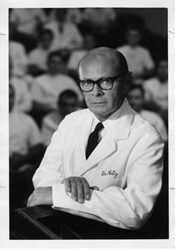
Artz, Curtis P. (1915-1977), was a renowned burn expert who joined MCSC in 1965 as professor and chairman of the department of surgery. He received his B.A. and M.D. from Ohio State University and did his graduate work in surgery at Baylor College. Before coming to Charleston, Artz served in the Army and was assigned to the Surgical Research Unit of the Brooke Army Medical Center, Fort Sam Houston, Texas. While there he founded the Army Burn Center and served as director of the Army Surgical Research team in Korea. Between 1956, when he left the army and the time he joined MCSC, Artz was a faculty member at the University of Mississippi School of Medicine at Jackson, and became the first Shrine Professor of Surgery at the University of Texas at Galveston. He was chairman of the Committee on Trauma of the National Research Council, president of the American Association for the Surgery of Trauma, and president of the American Trauma Society. He was also president of the Southeastern Surgical Congress. Much of Artz's research was in the area of surgical metabolism, shock, and burns.
Fletcher C. Derrick, Jr., M.D.
“Dr. Artz was chief of surgery, and he was a dynamic person; he was very active, very outspoken. He was able to get things moving.”
Lloyd L. Martin
“Dr. Artz was a mentor to me. He was like a family. We were a part of his family. Dr. Artz was just a teacher constantly. He never was too busy to stop and explain something.”
Derrick, Jr., Fletcher C.
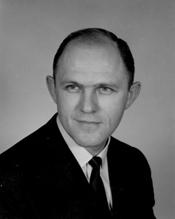
Derrick, Jr., Fletcher C. (1933- ), graduated from Clemson College in 1954 with a B.S. in Pre-Medicine and earned his M.D. at the Medical College of South Carolina in 1958. After medical school, he completed his internship at Martin Army Hospital, Ft. Benning, GA, and was then stationed in Germany with the 8th Division Artillery and at the 2nd General Hospital in Landstuhl. Upon returning to the U.S., he completed his residency at MUSC and served as a faculty member of the Department of Urology. In 1970, Derrick became a professor and chairman of urology at George Washington University. He returned to Charleston and opened a private urology practice in 1973, where he continues to see patients today. He also maintains a position as a clinical professor in Urology at MUSC.
Fletcher C. Derrick, Jr., M.D.
“Well, at that time, it was a learning process for all of us, so I think as we were looking and deciding, the most qualified person to remove a kidney and to also reimplant the ureter was a urologist. So, that was the role that as Dr. Fitts and Artz and I began to talk about doing the first transplant, then they asked me to join the team as a urologist, and I did.”
H. Biemann Othersen, Jr., M.D.
“He [Dr. Derrick] did the kidney removal from the donor. And that had to be done very carefully, of course, because here you have a patient who doesn't have anything wrong with her, and you want to be very sure that you create no harm; first of all, do no harm. So, you have to take out that kidney without endangering that patient who's donating the kidney, and that was his job.”
Fitts, Charles Thomas
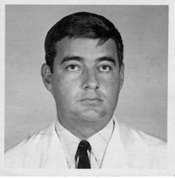
Fitts, Charles Thomas (1932-2008), was recognized as the creator of the MUSC organ transplant program because of his involvement in the 1968 kidney transplant. Fitts earned his B.A. from Princeton in 1953 and his M.D. from the University of Pennsylvania in 1957. Prior to joining MUSC in 1965, Fitts served as chief of the Trauma Study Branch, U.S. Army Medical Corps Surgical Research Unit, Brooke Army Medical Center, Fort Sam Houston, Texas. During his tenure at MUSC, Fitts held several appointments including professor of surgery, medical director of the South Carolina Organ Procurement Agency (SCOPA), and attending surgeon at Medical University Hospital and the Veterans Administration Hospital. He also served as director of transplant surgery and eventually became director of the MUSC transplant program. Dr. Fitts retired from MUSC in 1993.
Lloyd L. Martin
“Tommy Fitts kept me informed about -- he’d say [Lloyd], we're going to do so and so, Lloyd, we’re going to do this. You got to be ready. You and Tom [Hargest] have got to be ready. And so I worked with Tom.”
Graber, Charles David
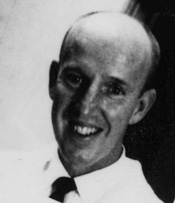
Graber, Charles David (1917-1996), was a recognized expert on the immunological response to transplant tissues and was often a member of kidney transplant teams when the procedure was new. Graber earned his B.S. in journalism from Ohio State University in 1939, his M.S. at the University of Colorado Medical School in Denver in 1954, and completed his Ph.D. in immunology from Ohio State University in 1957. While serving in the Army, Graber was assigned to the Army Research Unit in San Antonio, Texas, where he developed techniques to combat infection in burn patients. After being honorably discharged from the Army, Graber went on to teach at Emory University Medical School, Baylor University Medical School, and the Medical University of South Carolina, which he joined in 1966. At MUSC Graber taught microbiology until his retirement in 1983, at which time he became Professor Emeritus of Laboratory Medicine.
Lloyd L. Martin
“And all during the research that was going on for those two or three years, Charles [Graber], a microbiologist, was busy with his team of people downstairs from my labs -- or my operating rooms -- doing all of the serum work, separating the cells, trying to determine what was going to be helpful, how we could do this.”
Hargest, III, Thomas S.
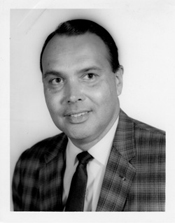
Hargest, III, Thomas S. (1925- ), received his B.A. from Lafayette College, Easton, PA, in 1950 and spent twelve years as a geophysicist/geologist in the petroleum industry. In 1964 he joined Dr. Curtis P. Artz, internationally know burn specialist, at the University of Texas Medical Branch, Galveston, as Engineering Consultant. When Dr. Artz was named Chairman, Department of Surgery, at the Medical College of South Carolina, Mr. Hargest joined him as Assistant Professor of Surgery, Bio-Engineering. He received certification as a clinical engineer by the International Certification Commission in 1975. Mr. Hargest was named Professor, Department of Surgery, and Director of Clinical Engineering in 1978. He holds numerous patents related to medical equipment and devices. Since his retirement in 1985 he has served as a consultant to various medical companies.
Lloyd L. Martin
“Tom Hargest was the one who developed the tips that we could put in the thoracic ducts that hooked onto Silastic tubing and came out of the animal and then collected in a bag.”
Lloyd L. Martin
“He [Tom Hargest] made all of the equipment that went into that patient [Billy Ashley].”
Harvin, James Shand
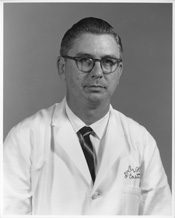
Harvin, James Shand (1929-1991), attended The Citadel and received his A.B. degree from Duke University in 1951. He earned his M.D. from the Medical College of South Carolina in 1953 and went on to complete his internship at Wayne County General Hospital and Infirmary, Eloise, Michigan, and a residency in general surgery at Barnes Hospital, St. Louis. Harvin entered the U.S. Air Force in 1954 and maintained his military association throughout his career. In 1967 Harvin was appointed to MCSC's Division of Plastic and Maxillofacial Surgery. He retired as chief of that division in 1987. The James Shand Harvin Society of Plastic Surgery was established in 1984 to honor his contributions to the field of plastic surgery.
Lloyd L. Martin
“I left the [operating] room and I know Dr. Fitts and Dr. Harvin closed Ashley back up and got him back to his room. Or got him in the ICU room, rather.”
Martin, Lloyd L.
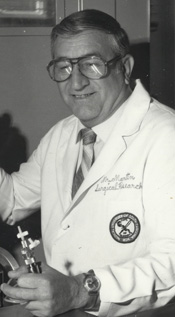
Martin, Lloyd L.(1920- ), began his long career in the medical field when he served as a combat medic in World War II. Between 1950 and 1964, Mr. Martin was stationed at a number of Army facilities including Brooke General Hospital, Fort Sam Houston, Texas; Fitzsimmons Army Hospital, Denver, Colorado; the U.S. Army Hospital in Munich, Germany; and the Fort Sam Houston Burn Center. It was during his time at the Burn Center that Mr. Martin met and worked for Curtis P. Artz, M.D. When Dr. Artz moved to the University of Texas at Galveston in 1964, Mr. Martin went with him to supervise Dr. Artz’s surgical research laboratory. Dr. Artz then recruited Mr. Martin to the Medical College of South Carolina in 1966 to run his surgical laboratory. Mr. Martin served as Director of the Department of Surgery’s Surgical Research Laboratories for fifteen years. His duties consisted of maintaining laboratory equipment and supplies and training laboratory technicians. Mr. Martin also served as chief organ preservation technologist for MUSC’s Renal Transplant Program beginning in 1971 until 1980. Mr. Martin retired from MUSC in 1984.
Lloyd L. Martin
“And I was only to do one thing. I was to go in and get one of the surgical techs to pass -- I was scrubbed and in a gown, gloves, everything, as if I was going to be at the table. I set up another table over in the side of the operating room to profuse the kidney that would come into that room. And my little table was all sterile, and it had a whole row of Tom Hargest’s tips and Silastic tubing to do the profusion with, and I had an ice chest with six bottles of [cold] ringers at a 35-degree temperature, that was going to cool a kidney down and keep it from deteriorating any more than possible after they removed it and took it away from its blood supply.”
Othersen, Jr., H. Biemann
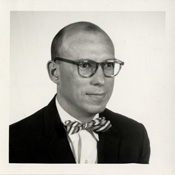
Othersen, Jr., H. Biemann (1930- ), is a recognized expert in the surgical care of children. He joined the faculty at the Medical University of South Carolina in 1965 as an assistant professor of surgery and as the university's first chief of pediatric surgery. Prior to joining MUSC, Othersen earned his M.D. from MCSC in 1953 and spent the following 12 years pursuing his post-graduate surgical training at Philadelphia General Hospital, the University of Pennsylvania, MCSC, the Children's Hospital in Columbus, Ohio, and Massachusetts General Hospital. At Massachusetts General Hospital, Dr. Othersen spent a year in the transplant lab conducting research on rats and dogs. Dr. Othersen has held a number of key leadership positions within the Medical University, including medical director of Medical University Hospital, associate medical director of MUSC, the first medical director of MUSC's Children's Hospital and emeritus chief of pediatric surgery.
H. Biemann Othersen, Jr., M.D.
“I had experience in lymphocyte depletion through a different mechanism, not through the mechanism of draining the lymphocytes, but through anti-lymphocyte serum that was raised in horses. So, that's how I got to be part of the team.”
Lloyd L. Martin
“And in a few minutes, here comes Dr. Othersen with the kidney in his hands and immediately put it in one of the cold basins, and he selects the size of one of the tubings to go in to flush it with, and we hook the cold ringers -- one of the OR techs hooks it up for us and hands off the tip. He flushes it all out. Blood come out. And we kept moving it from bowl to bowl until we finally got to a bowl where no more red cells were coming out, and it was cold throughout the whole core.”
H. Biemann Othersen, Jr., M.D.
“I had experience in lymphocyte depletion through a different mechanism, not through the mechanism of draining the lymphocytes, but through anti-lymphocyte serum that was raised in horses. So, that's how I got to be part of the team.”
Williams, Arthur V.
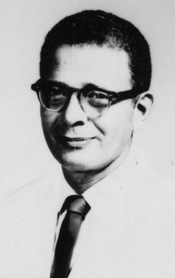
Williams, Arthur V. (1919-2007), was a recognized leader in the fields of nephrology and hemodialysis in South Carolina. He earned his B.S. in Biology from Clemson College in 1940 and his M.D. from MCSC in 1943. During his residency at the Marquette University School of Medicine, Williams worked with the Developmental Division of Allis-Chalmers in designing the Kolff type artificial kidney. In 1950. Williams entered private practice in Charleston where he practiced internal medicine until 1966 when he became a full-time faculty member at MCSC. At MCSC, Williams served as head of the Hemodialysis Unit and Director of the Division of Nephrology from 1970 until his retirement in 1989.
Fletcher C. Derrick, Jr., M.D.
“Dr. Williams was a nephrologist, and of course he was going to be the one to primarily take care of the patient after surgery when it came to the renal function, as far as that was concerned.”
H. Biemann Othersen, Jr., M.D.
“So, we had a good hemodialysis program, and Dr. Arthur Williams was good at that, so he felt that he could maintain the patient without kidneys.”
Joyce A. Townes
“Dr. Williams was the main one. I mean, I met him and that was it. And I just put my faith in him because he was just that good of a doctor. He was more like a father to me, because I wasn’t but 23 [years old]. He couldn’t have been any closer if he had been my brother or daddy or something. He really cared about people. He did, and he would take care of you if you needed anything. You don’t find doctors like that.”
